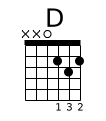Learning Your First Chord
Here’s a chord chart for your first chord, ‘D’ (or D-major). The chart shows everything you need to know to play the chord: strings played, ‘fretted’ positions, and fingers used. Let’s discuss in more detail how a chord chart works.
Here is how to read the above chord chart:
- The chart is an image of the neck of the guitar from straight on; the solid line at the top is the ‘nut’; the horizontal lines are the fret bars. Note that this chart shows you up to the 5th fret. If that is hard to visualize, stand your guitar upright; you are looking at the top of the neck from the nut down to the 5th fret.
- The dots are where your fingers go to press down on the strings.
- The finger numbers you should use are noted on the bottom of the chart. Fingers are numbered as: 1=index, 2=middle, 3=ring, and 4=pinky. Your thumb is generally used for muting the low-e string; more on that later.
- The “X” and “O” at the top (underneath the chord name) denote strings you should not play ‘X’, and open strings ‘O’. Often, strings that are not played are muted so you don’t have to restrict your strumming (more on that later).
Place your fingers as noted in the above chord chart, and strum the bottom 4 strings with your pick. Your chord is probably not ringing cleanly (some of the strings may sound like they are being muted). Here are some tips for getting chords to ring cleanly:
- You should finger the chords with your finger tips. Pretend that you are driving your fingernails into the wood of the neck; this will give you the correct finger tip position.
- Keep as close to the back of the fret bar – just behind the bar – as possible. The closer to the back of the bar you are, the easier it is to get a clean chord. Even an eighth of an inch makes the world of difference to a beginner.
- Keep your thumb over the top of the neck on all chords. This does two things: first, it prevents you from bending your wrist, which can lead to soreness and possibly having to stop playing. And second, the thumb is often used for muting the low-e string when it’s not used in a chord (the ‘X’ string in your diagram), and it’s important on many chords; more on that later.
If you are working with an instructor, which we hope you are, they will help you to finger the chord correctly, and get it to sound as ‘clean’ as possible in your lesson. They should also show you how to use your thumb to mute the low-e string – an essential skill which allows you to always strum all strings without restriction.
Your job in between the lessons is to stick to the principal’s above, take your instructor’s advice and tips, and practice until your “D” chord sounds ‘clean’; in other words, none of the strings played are muted, and all ring cleanly – you’ll know when it does! It takes some work, but with a couple of short 15-minute practice sessions each day, in a week or so you’ll nail it.
If you are interested in learning more beginner guitar techniques, see our book “Learn to Play Guitar for Adult Absolute Beginners“.
If you are a beginner guitarist, a few lessons with a professional instructor can go a long way. If you’re not local to Manchester, New Hampshire, we offer online guitar lessons, which are fun, affordable, and can really help, especially if you’re struggling in a particular area. You can schedule an online lesson HERE. We would love to help you out, either in-studio, or online. Happy learning!

